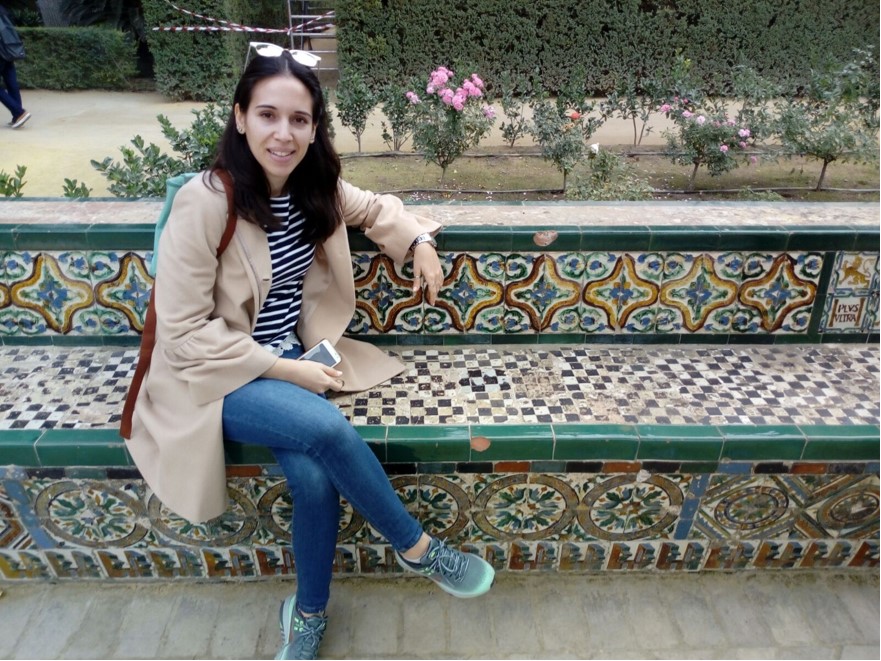Today, we’re interviewing Emily Leonidou — a final year PhD researcher in Medicinal Chemistry who loves growing, cooking and eating food. Read on to know what it takes to be a flexitarian, how to start your own kitchen garden and how your seemingly small efforts can save the planet.
1. What made you a food blogger?
I started my food account during the initial COVID lockdown in the UK. I’ve always enjoyed cooking and during the lockdown, I had a lot more time to do that. I decided to share my journey with people to inspire more delicious home cooking (especially important as a lot of restaurants were closed).
2. On a scale of 1-10, how much do you love Mediterranean cuisine?
10! I Grew up eating Mediterranean food so it holds a special place in my heart. I also think it’s one of the most balanced and healthy cuisines so it’s also good for you.
3. What’s your favourite dish and why?
This is a really tough question, I love eating soooo many things! I think anything with seafood like grilled octopus (my favourite thing to eat when I am back home in Cyprus) or a good prawn pad thai.
4. Your favourite regional cuisine is…
Other than Mediterranean, it’s Thai! I love Thai curries and stir-fries as they are so flavourful and aromatic.
5. You recently cooked Usal (a Maharashtrian dish). What other Indian dishes do you plan to try?
I really enjoyed eating the Usal, it’s definitely not your typical curry and I actually made it a couple of times since first trying it. I plan on exploring more regional Indian recipes in the future but I don’t have a particular recipe in mind. Maybe something with paneer?
6. Name 3 dishes you can make easily from discards/leftovers.
Fried rice, curry, omelette (or something else that incorporates eggs).
7. What made you transition into a low waste, sustainable cook?
I would say that I try to have a sustainable lifestyle, rather than just being a sustainable cook. I remember first learning about the environment when I was in elementary school and the importance of recycling to get rid of some plastics from landfills etc. Later on, as I was growing up, I started realising that the best thing we can do is to avoid generating that waste in the first place. We only have one Earth to live on and I think it is very important to do our best to protect it/minimise the damage we do to it. I now make a more conscious effort to reduce the amount of waste I generate and to be more sustainable in general. This is also why I cut down on my meat consumption and started eating more plant-based meals.
8. According to you, what does sustainable cooking look like?
For me, sustainable cooking involves a mostly plant-based diet with the occasional meat/fish and is about reducing waste (both in terms of food and packaging/plastic).
9. Is sustainable cooking more expensive than ‘normal’ cooking?
This heavily depends on how you define sustainable cooking, and how you go about doing it. In general, I find that for me this type of cooking is cheaper than ‘normal’ cooking as a lot of the foods I eat (like beans, rice, fruits and veggies, eggs) are cheaper than buying meat/fish. Additionally, as I almost never throw food away, I make the most of what I paid. Some of the vegan meat alternatives, however, can be just as expensive as meat though.
10. Who is your inspiration and why?
For gardening, it’s my grandfather. He grows everything (fruits and vegetables) that he and my grandmother need which I find amazing! I do hope that one day I will be able to do the same. For cooking, it’s my grandmother as she can make delicious meals with very simple ingredients.
11. Name three food items that you always pick from the supermarket.
Tomatoes, eggs and carrots.
12. Name five vegetables that are super easy to grow and require less supervision.
Herbs (mint, parsley, basil, chives etc) are probably the easiest thing to grow, and this can be done indoors by a windowsill. Other than that, I personally found it very easy to grow radishes, potatoes, onions and salad greens (e.g. lettuce).
13. Five tips for someone wanting to start their own kitchen garden.
- Do it slowly. Start with a couple of easy things to grow and add more over time.
- Do your research! Weather conditions/climate heavily influence when/what you can grow so choose wisely.
- Don’t be too hard on yourself. It won’t necessarily be easy at the beginning, but all new things need time.
- Learn from your experience. If you see that something isn’t working, then change tactics.
- Enjoy it! Growing things is fascinating for me and I love seeing how a tiny seed can then produce so much food.
14. Name five essentials for someone wanting to start a kitchen garden on a low-budget.
- Instead of buying seeds/seedlings, save seeds from your fruit and veg and use these to regrow plants (e.g. from bell peppers, chilli peppers, tomatoes, cucumbers, courgettes, sprouted potatoes etc).
- Compost food scraps to create your own soil.
- Never throw away pots, keep reusing them!
- Repurpose things as pots (e.g. old plastic boxes, big yoghurt tubs, empty large plastic bottles (water, detergent, fabric softener etc).
- There is no need to buy specialised gardening equipment, use normal household items instead (e.g. water bottle/jug for watering instead of buying a watering can etc).
15. Three lesser-known gardening tips for our readers…
- Use neem oil as a natural insecticide/fungicide.
- Add leftover coffee/coffee grinds to your soil to act as a fertiliser.
- Add crushed eggshells to increase the amount of calcium in your soil.
16. A cookbook you swear by…
Simple, by Yotam Ottolenghi!
17. Tell us about your most memorable day in the kitchen.
I love exploring new dishes from around the world and getting creative in the kitchen, so any day that I get to try a new recipe is memorable.
18. A food trend that’s a complete lie…
Rainbow anything (bagels, cake etc). I don’t get why someone would want to eat something so artificial looking! Don’t get me wrong, I do love a colourful plate of food that is full of vibrant fruits and vegetables. Nature is full of colours and we should celebrate that in every possible way. My problem is when that gets replaced by tasteless food colouring…
19. What are your thoughts on Veganism?
I think veganism is really good for the environment and animal welfare, but I do understand that it is not for everyone. I did go vegan for two months last year to try it and although I felt really good, I didn’t think it was sustainable for me. This is mostly because of the added ‘stress’ my friends and family had in order to cater for me, both during family meals at home and when eating out (making sure that the restaurant would have a vegan option etc). I, therefore, decided to switch to a flexitarian diet instead which for me is the best of both worlds.
20. The secret of cooking great food is…
Doing it with love and not being afraid of getting creative!
21. When you’re not cooking you can be found doing?
Going for walks, doing yoga or watching Netflix.
22. Five restaurants you’d like to visit and for which dish?
- The Fat Duck, by Heston Blumenthal (UK) for the tasting menu
- Centrale, by Virgilio Martinez Feliz (Peru), again for the tasting menu
- Raan Jay Fai, by Jay Fai (Thailand), for the crab omelette and crab yellow curry
- Noma, by Rene Redzepi (Denmark), for the tasting menu
- Mugaritz, by Andoni Luis Aduriz (Spain), for the tasting menu
(I’m starting to see a theme here with all these tasting menus, haha! I want to try so many things!)
23. What are your future plans? Do they include a sustainable cafe/restaurant at any point in time?
My plan for the near future is to finish my PhD, but I really don’t know what I want to do afterwards. The idea of opening my own sustainable cafe sounds amazing though!
24. Your recipes are nutritious and look delicious. Shall we be expecting a cookbook anytime soon?
Aww, thank you so much! I don’t think a cookbook is in my plans though. Not now anyway…
25. Three low-cost sustainable dishes for students would be…
Egg and veg fried rice, bean chilli (served with rice) and Mediterranean pasta salad (with chickpeas, olives, tomatoes, bell pepper, onion and feta cheese).
26. We’ve only seen you feature a beverage (homemade raspberry ‘citrusade’) once. Are you not fond of smoothies/other beverages?
No, I usually drink lots of water. I’m not a big fan of alcoholic drinks and I don’t like coffee or soft drinks. I do enjoy fresh juices though, my favourite is an orange and pomegranate fresh juice I get from a trader in my local market!
27. While you can source your own fruits and vegetables in your own garden, tell us some things to keep in mind when purchasing meat and other poultry items?
Unfortunately, the amount of produce I grow is not enough (both in terms of variety and amount) so I still have to buy certain things. When I do, I try to buy as many of them as possible in an unpackaged form. I can very happily say that more than 90% of the fresh produce I now buy doesn’t come with unnecessary plastic packaging 🙂 Regarding purchasing meat items, I try to avoid that as much as possible. Due to health and safety concerns, meats always come packaged. In order to minimise the waste this generates, try to buy in bulk and freeze some for future use. Additionally, aim to buy unprocessed meat and add herbs, spices etc yourself. This will almost always be much healthier than e.g. pre-marinated meats or meats that have been processed in other ways (nuggets etc) and is also cheaper!
28. Your menu for a barbecue would include…
Cypriot lamb souvla (large pieces of lamb on the bone cooked slowly over white-hot charcoal), BBQed halloumi and vegetable skewers, salad, tzatziki and baked potatoes.
29. If you could dine with one person in this world, who’d that be and what’d you order?
Interesting question…I think I would dine with Yotam Ottolenghi, but I would let him take care of the ordering!
30. One recipe you’d like to share with our readers…
Cypriot fried zucchini flowers
Ideal as an appetiser for 4-5 people
Time taken: 15 minutes
Ingredients:
-12-15 zucchini flowers (ideally 1 day old so that they are slightly wilted and not very fragile)
-about ½ halloumi, cut into strips
-100 g all-purpose flour
-200 g water
-1 tsp baking powder
-1 tsp salt
–oil for frying (ideally olive oil)
-1 tsp black pepper
Method:
- Remove the small green leaves and stem from the zucchini flowers. Wash and leave aside to try.
- Make the batter by combining the flour, water, baking powder, salt and pepper. Whisk well until there are no lumps.
- Open each flower and place a halloumi strip in its center. Close the petals around the cheese and twist the top.
- Dip each stuffed flower into the batter, and then directly transfer to the frying pan (with the pre-heat your oil).
- Shallow fry for a couple of minutes on each side, until golden brown and crispy.
- Remove and place on a plate lined with a kitchen towel to absorb any excess oil.
- Enjoy while still warm 🙂
Follow Emily Leonidou on Instagram at eats_by_leo.
Shristi is an avid reader, recipe developer and wellness enthusiast. She’s probably making a mess in her kitchen right now.

